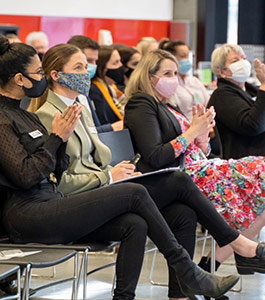Left: Susan Alberti AC, Patron, Tradeswoman Australia, Peta Murphy MP, Federal Member for Dunkley and Fiona McDonald, Managing Director of Tradeswomen Australia at Frankston last Friday.
The Patron of Tradeswomen Australia, Susan Alberti AC, and the Managing Director, Fiona McDonald, last week met Federal Member Peta Murphy MP in Frankston, to discuss boosting women’s workforce participation in the trades nationally.
Susan Alberti AC and Fiona McDonald, on behalf of Tradeswomen Australia, presented the Federal Member for Dunkley, Peta Murphy MP, with a hammer and nail bag as a symbol of women becoming increasingly important to the future of Australia’s building and construction industry.
Ms McDonald said an analysis of the jobs held by the resident population in Frankston City in 2019 showed 24% had a trade certificate against the Victorian average of 17%. “It is important to harness the skills and talents of women in all trade areas to work alongside men and expand the trade and production capacity of Australia as a nation.
“One of the major challenges to improve the number of women included in the trades starts with the provision of more information for career counsellors in schools and creating an awareness of the increasing number of women entering the trades.
“Currently in major trades such as automotive, carpentry and plumbing, women account for just 2% of employment, a level which has existed for a quarter of a century.”
Tradeswomen Australia was established to encourage, recruit, and retain women in skilled trade roles that are male dominated. By recognising the need for change in social attitudes Tradeswomen Australia supports businesses to take the lead and remove the barriers for women who wish to enter their trade.
The National Skills Needs List (2019) lists 65 trades that are experiencing national skills shortages. Of those, 62 can be classed as male-dominated trades, only 3 could be classed as female-dominated. There is no reason why these roles could not be filled by women who make up 50% of Australia’s population.
‘Women bring a positive impact to the trade workforce creating a culture and behavioural change, improved attention to detail, planning and organisation, improved communication, dedication, and maturity.’ * ¹
“In the context of current skills shortages in Australia, under-representation of women in key industries is not only bad for gender equality, it undermines Australia’s economy and growth opportunities,” Ms McDonald said.
‘Boosting women’s workforce participation is essential to raising living standards and securing Australia’s future prosperity. It has the potential to add up to $25 billion to the Australian economy.’ * ²
Gender workplace statistics at a glance 2019-20
February 2020
Workforce Participation
- Women comprise 47.4% of all employed persons in Australia; 25.8% of all employed persons are women working full-time, and 21.6% are working part-time* (ABS 2020, Labour Force).
- Women constitute 37.7% of all full-time employees and 68.2% of all part-time employees (ABS 2020, Labour Force).
- The workforce participation rate** is 61.4% for women and 70.9% for men (ABS 2020, Labour Force).
- The workforce participation rate among those aged 15-64 years is 74.5% for women and 83.1% for men (ABS 2020, Labour Force).
Resource:
The Gender Equality Council Website: https://www.wgea.gov.au/data/fact-sheets/gender-workplace-statistics-at-a-glance
References:
¹ ‘Perfect for a woman’
² ‘Towards 2025 – An Australian Government Strategy to Boost Women’s Workforce Participation’
Media Enquiries:
Ron Smith, Media Communications, Tradeswomen Australia –
Mobile: 0417 329 201






